iPhone X Revealed: “The future of the smartphone”
The iPhone 8 may have just been announced, but all eyes are on its swankier sibling, the iPhone X. Here’s the latest on the iPhone 8, or read on for everything you need to know about iPhone X.
Though it was announced alongside the iPhone 8 and 8 Plus, which are iterative improvements over the 7/7 Plus, the iPhone X is something else entirely and could potentially be the iPhone we’ve been waiting for.
Before I go into detail about Apple’s most exciting phone in years, here is everything you need to know about the iPhone X in a nutshell:
- iPhone X Design: 143.6mm x 70.9mm x 7.7mm, 174g, Glass on front and back – surgical grade stainless steel frame, water-resistant IP67, no Home button
- iPhone X Screen: 5.8-inch HDR OLED edge-to-edge display, 2436 x 1125 pixel resolution (458ppi)
- iPhone X Specs: Apple A11 Bionic 6-core SoC with Apple GPU, Face ID, Stereo speakers, Fast-charge capable (50% charge in 30 minutes), Wireless charging, iOS 11
- iPhone X Camera: Dual 12-megapixel camera, f/1.8 and f/2.4 aperture, Dual Optical Image Stabilisation, Faster Image Signal Processor (ISP), Portrait Mode on front and rear camera
- iPhone X Price: From £999/$999
- iPhone X Release Date: October 27 (pre-order), November 3 (release date)
With that out of the way let’s dig a little deeper and examine why the iPhone X could be the most exciting Apple phone ever made.

iPhone X Design: A bold new look
The iPhone 7 saw the radical decision to remove the headphone jack. That notorious design change has already been surpassed by the removal of the iPhone’s most iconic feature: the iPhone X has no Home button. And don’t expect to see it come back.
Those who have used recent flagship Android phones will be used to the lack of any buttons crammed below the screen or on the back. The Samsung Galaxy S8 and LG G6 have both beaten Apple to this punch. It’s easy to get used to and the extra screen real estate you get removing the button makes it well worth it in my eyes.
But if you’ve been an iPhone user for years this is potentially a big hit. The Home button was a simple way of navigating the increasingly complex maze of smartphone functionality. It has been the go to way of getting back to the comfort of the home screen. The iPhone X will still let you do that easily, of course, just not with a physical button. Instead you’ll be able to get home by swiping up from the bottom of the screen.
The removal of the Home button has allowed Apple to load the iPhone X with a much bigger screen than the iPhone 7, without making it much larger. We now have a 5.8-inch screen in a svelte glass and metal body. This is the best-looking iPhone since the iconic iPhone 4.
Of course the headphone jack hasn’t made a comeback so you’ll still need to use either Lightning cabled headphones or wireless headphones, Apple also has its own wireless Airpods as accompaniment for the iPhone X.
iPhone X Camera: Faster and better low-light performance
While it might not sound like much has changed in terms of specs – still 12-megapixel, f/1.8 aperture for the main rear camera – there are important advancements to the iPhone X’s camera. Pixels are larger and the Image Signal Processor (ISP) is much faster. Apple also promises 83% more light in the photos and 36% for the second rear sensor. Importantly the second rear camera, which allows both optical zoom in photos and Portrait Mode, now has Optical Image Stabilisation (OIS). That’s the edge the iPhone X has over the dual cameras on the iPhone 8 Plus. It also marks it as a more interesting camera than the single-sensor one on the Samsung Galaxy S8.
These improvements may not sound ground-breaking, but the iPhone X should snap far better low-light photos with reduced noise. This is the challenge all smartphones cameras tend to struggle with.
The pixels on the iPhone X also come with a new colour filter to provide more accurate, and deeper, colours in photos.
The iPhone X also arguably comes packing the most advanced selfie camera we’ve ever seen on a smartphone. The front-facing camera on the iPhone X not only lets you securely unlock your phone using your face (don’t worry – it works in the dark too), it also lets you take Portrait photos. This means you can apply the same great background-blur effects the rear camera provides to your selfie shots.
ARkit is another card up the iPhone X’s sleeve. Augmented reality lets you mix digital and real world environments, Pokemon Go is the most famous use of this technology. While AR gaming is certainly something Apple is plugging with the iPhone X, it will also allow useful apps that let you, for example, plan your living space and see how furniture will fit into it digitally.

iPhone X: Release date and price
As many of us expected, the iPhone X won’t be launching immediately alongside Apple’s other two new handsets.
Instead, likely due to the oft-rumoured supply chain issues, it’s going to be available for pre-order from October 27 ahead of a November 3 release date.
Pricing is set to start at $999, which is around £750 based on a straight currency equation – but don’t expect to get it for that. We’d expect the iPhone X to start at least £899 here in the UK, and maybe cost more.
Want to ensure you’re first in line? Follow the link below and register your interest today.


Comments
Post a Comment